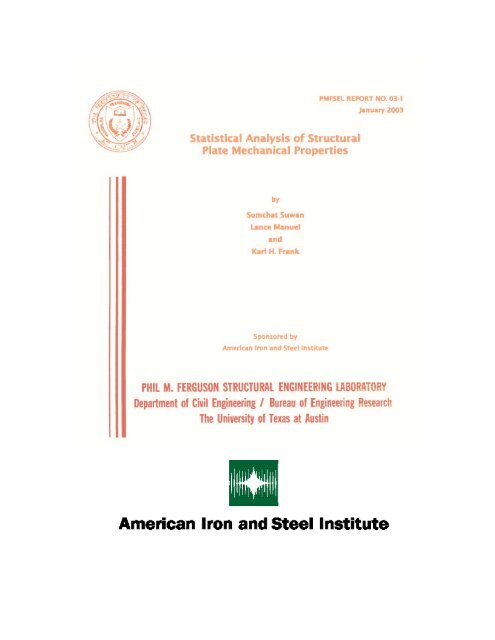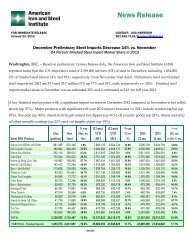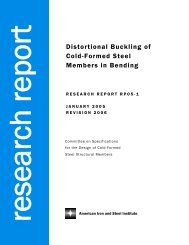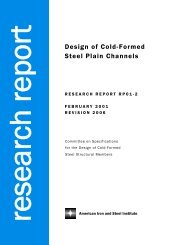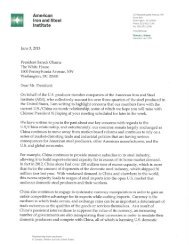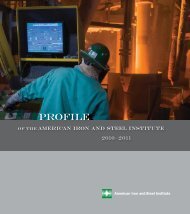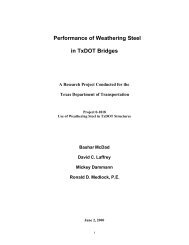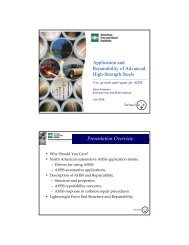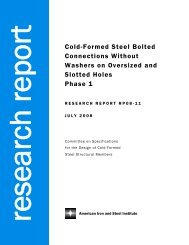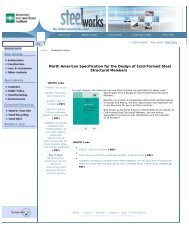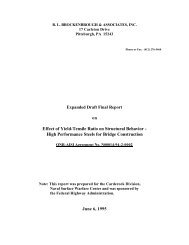Statistical Analysis of Structural Plate Mechanical Properties (Part 1)
Statistical Analysis of Structural Plate Mechanical Properties (Part 1)
Statistical Analysis of Structural Plate Mechanical Properties (Part 1)
You also want an ePaper? Increase the reach of your titles
YUMPU automatically turns print PDFs into web optimized ePapers that Google loves.
STATISTICAL ANALYSIS OF STRUCTURAL<br />
PLATE MECHANICAL PROPERTIES<br />
FINAL REPORT<br />
Prepared for<br />
American Iron and Steel Institute<br />
Somchat Suwan<br />
Lance Manuel<br />
Karl H. Frank<br />
Department <strong>of</strong> Civil Engineering<br />
The University <strong>of</strong> Texas at Austin<br />
January 16, 2003
Acknowledgement<br />
This work was sponsored by the American Iron and Steel Institute (AISI) and was<br />
performed for the AISI Technical Committee on <strong>Plate</strong>s.<br />
ii
FORWARD<br />
This work was sponsored by the American Iron and Steel Institute (AISI) and was<br />
performed for the AISI Technical Committee on <strong>Plate</strong>s. In 1974, AISI published a report<br />
dealing with variations found in hot-rolled steel plate. Entitled “The Variation <strong>of</strong> Product<br />
<strong>Analysis</strong> and Tensile <strong>Properties</strong>: Carbon Steel <strong>Plate</strong>s and Wide Flange Shapes”, that<br />
report described the probability that tensile properties may differ among test locations<br />
within a plate other than the reported test location. In 1979 and again in 1989, AISI also<br />
published informational reports entitled “The Variations in Charpy V-Notch Impact Test<br />
<strong>Properties</strong> in Steel <strong>Plate</strong>s”.<br />
In 1998, the AISI Technical Committee on <strong>Plate</strong>s and Shapes included in their Workplans<br />
an item to update the aforementioned studies to reflect current mill practice. By the end<br />
<strong>of</strong> 1999, an acceptable proposal and format was developed with the University <strong>of</strong> Texas<br />
at Austin under the direction <strong>of</strong> Dr. Karl Frank, Department <strong>of</strong> Civil Engineering. Data<br />
was eventually collected from participating members <strong>of</strong> the AISI Committee and<br />
forwarded anonymously for inclusion in this study.<br />
The following report describes the extensive analysis <strong>of</strong> the current data that includes<br />
both tensile and Charpy V-Notch data. Due to constraints, complete chemical data that<br />
could compare differences in product analyses within plates and from plate to plate could<br />
not be accomplished by the participating mills. An excellent treatment <strong>of</strong> the results is<br />
detailed within this report. The overall values described in these results have changed<br />
greatly from the previous studies. This is mainly due to the effects <strong>of</strong> better quality and<br />
the fact that higher strength steels have become the focus <strong>of</strong> production now compared to<br />
thirty years ago when much <strong>of</strong> the data dealt with lower strength steels. It is important to<br />
note that while this is true, the variations encountered in the treatment <strong>of</strong> the data have<br />
remained largely comparable. One interesting observation on tensile properties is that as<br />
iii
a function <strong>of</strong> required minimum strength, yield strength has a smaller standard deviation<br />
compared to the earlier data. Another is the nearly three-fold increase in absorbed energy<br />
values reflecting the improved quality <strong>of</strong> the more current steels.<br />
On behalf <strong>of</strong> the Committee, I would like to thank Dr. Karl Frank and his staff for a<br />
thorough and detailed report. I would also like to personally thank those members <strong>of</strong> the<br />
<strong>Plate</strong> Committee who provided extensive data at great expense <strong>of</strong> time and money to their<br />
companies and for their continued dedication to the completion <strong>of</strong> this Workplan.<br />
Kenneth E. Orie<br />
Chairman, AISI Technical Committee on <strong>Plate</strong>s<br />
iv
TABLE OF CONTENTS<br />
Chapter Page<br />
CHAPTER 1– INTRODUCTION<br />
1.1 Introduction 1<br />
1.2 Scope <strong>of</strong> Research 1<br />
CHAPTER 2 - DATA DESCRIPTION AND PREPARATION<br />
2.1 Description <strong>of</strong> Data 3<br />
2.1.1 The 4-Mill Group 3<br />
2.1.2 The 2-Mill Group 5<br />
2.2 Data Preparation 5<br />
2.3 <strong>Properties</strong> to be Studied 9<br />
2.3.1 Carbon Equivalent 9<br />
2.3.2 Yield Strength 9<br />
2.3.3 Tensile Strength 10<br />
2.3.4 Yield to Tensile Ratio 10<br />
2.3.5 Yield Strength to Yield Point Ratio 10<br />
2.3.6 Charpy V-Notch Toughness 11<br />
CAHPTER 3 – ANALYSIS OF DATA<br />
3.1 Carbon Equivalent 12<br />
3.1.1 Organized Data from 4-Mill Group 13<br />
3.1.2 <strong>Statistical</strong> <strong>Analysis</strong> Results from All Mills 16<br />
3.1.3 Correlation Studies Involving Carbon<br />
Equivalent 18<br />
3.2 Yield Strength 23<br />
3.2.1 Organized Data from 4-Mill Group 23<br />
3.2.2 <strong>Statistical</strong> <strong>Analysis</strong> Results from All Mills 25<br />
3.2.3 Distribution <strong>of</strong> Sampled Yield Strength<br />
Values 27<br />
3.3 Tensile Strength 29<br />
3.3.1 Organized Data from 4-Mill Group 29<br />
3.3.2 <strong>Statistical</strong> <strong>Analysis</strong> Results from All Mills 31<br />
3.3.3 Distribution <strong>of</strong> Samples Tensile Strength<br />
Values 33<br />
v
3.4 Yield to Tensile Ratio 34<br />
3.4.1 Organized Data from 4-Mill Group 34<br />
3.4.2 <strong>Statistical</strong> <strong>Analysis</strong> Results from all Mills 36<br />
3.5 Yield Strength to Yield Point Ratio 38<br />
3.5.1 Organized Data for Mill 4 38<br />
3.5.2 <strong>Statistical</strong> <strong>Analysis</strong> Result for Mill 4 38<br />
3.6 Charpy V-Notch Toughness 40<br />
3.6.1 Organized Data from the 4-Mill Group 40<br />
3.6.2 <strong>Statistical</strong> <strong>Analysis</strong> Results from All Mills 45<br />
3.6.3 Reference Location Effect in Charpy<br />
V-Notch Tests 64<br />
3.6.3.1 Reference Location Effect as a<br />
Function <strong>of</strong> Toughness 77<br />
3.6.4 Correlation between Absorbed Energy<br />
And Lateral Expansion 82<br />
3.7 Comparison <strong>of</strong> the Present Study and the<br />
Past Studies 85<br />
3.7.1 Tensile <strong>Properties</strong> 85<br />
3.7.1.1 Tensile Strength 85<br />
3.7.1.2 Yield strength 90<br />
3.7.2 Charpy V-Notch Toughness 94<br />
3.7.2.1 Thickness Versus Absorbed Energy Plots 94<br />
3.7.2.2 Three-test Average <strong>of</strong> Absorbed Energy 99<br />
3.7.2.3 Three-Test Average <strong>of</strong> Lateral Expansion 100<br />
3.7.2.4 Differences in Three-Test Average <strong>of</strong><br />
Absorbed Energy from Reference Location 101<br />
3.7.2.5 Correlation Between Absorbed Energy<br />
And Lateral Expansion 106<br />
CHAPTER 4 – CONCLUSIONS<br />
4.1 Summary <strong>of</strong> Results 110<br />
REFERENCES 113<br />
vi
CHAPTER 1<br />
INTRODUCTION<br />
1.1 INTRODUCTION<br />
The purpose <strong>of</strong> this research is to survey the mechanical properties <strong>of</strong> A572 and<br />
A588 plates produced in North America. The study focuses on three aspects: chemical<br />
properties, tensile properties, and toughness properties. Results from this study can be <strong>of</strong><br />
benefit to specification-writing bodies and other users interested in the variability <strong>of</strong><br />
mechanical properties <strong>of</strong> A572 and A588 plates. The results can also help update present<br />
databases on plate properties that do not include modern production techniques and new<br />
mills and producers.<br />
1.2 SCOPE OF RESEARCH<br />
The test results were supplied by a total <strong>of</strong> six mills from five producers in North<br />
America. Steel plates <strong>of</strong> both A572 and A588 grade from a total <strong>of</strong> 1,326 heats were<br />
analyzed. Overall statistical summaries were computed for carbon equivalent (CE), yield<br />
strength, tensile strength, yield to tensile ratio, and yield point to yield strength ratio.<br />
The statistical relationship between carbon equivalent and (i) yield strength; (ii)<br />
tensile strength; and (iii) yield to tensile ratio was also studied.<br />
A statistical analysis <strong>of</strong> the Charpy V-Notch toughness test results was conducted<br />
based on sixty-nine A588 and A572 steel plates from four <strong>of</strong> the six mills who<br />
participated in the survey. The study was conducted for three test temperatures (0°F,<br />
40°F, and 70°F), four thickness groups (T1 to T4, defined later), and two steel grades<br />
(A572 and A588). Additionally, a detailed study was conducted in order to compare the<br />
variability within a plate with the variability between plates.<br />
The effect <strong>of</strong> the selection <strong>of</strong> a reference location (from among the 7 possible<br />
sampled locations) with respect to absorbed energy was studied. This was done<br />
separately for low- and high-toughness plates. This effect <strong>of</strong> reference location was<br />
studied by computing the percentage <strong>of</strong> samples that had absorbed energy values greater<br />
than a specified level below the absorbed energy associated with the reference location.<br />
Finally, absorbed energy and lateral expansion were studied jointly in order to estimate<br />
2
the statistical correlation between these two parameters as obtained from results <strong>of</strong> the<br />
Charpy V-Notch tests.<br />
3
CHAPTER 2<br />
DATA DESCRIPTION AND PREPARATION<br />
2.1 DESCRIPTION OF DATA<br />
Five North American steel producers participated in this study and provided data<br />
on steel properties from six mills. The test results from these producers were supplied to<br />
the University <strong>of</strong> Texas at Austin in the form <strong>of</strong> EXCEL spreadsheet files. The duration<br />
for collecting the data from all the producers was a six-month period from January to<br />
June 2002.<br />
It should be noted that a mill number was assigned for each mill that participated<br />
and was used for reference instead <strong>of</strong> a producer name throughout this study. The<br />
number assigned to a mill was done according to the order that the test results were<br />
received from the mills.<br />
Mills 1, 3, 4, and 5 submitted data corresponding to the requested standard<br />
spreadsheet format. However, Mills 2 and 6 only submitted mill test data for the plates<br />
tested.<br />
2.1.1 THE 4-MILL GROUP<br />
The data files from Mills 1, 3, 4, and 5 (we will refer to these mills as the “4-mill<br />
group”) contained the following information for each plate:<br />
1. Name <strong>of</strong> Producer<br />
2. Mill<br />
3. ASTM Specification<br />
4. Type <strong>of</strong> Specification<br />
5. Heat No.<br />
6. Casting Method<br />
7. <strong>Plate</strong> Thickness<br />
8. Discrete Length or Coil<br />
9. As-Rolled <strong>Plate</strong> Width<br />
10. As-Rolled <strong>Plate</strong> Length<br />
4
11. Method <strong>of</strong> Production<br />
12. Chemistry (Heat <strong>Analysis</strong>) including the following elements:<br />
Carbon, Manganese, Phosphorus, Sulfur, Columbium, Vanadium,<br />
Nitrogen, Silicon, Copper, Aluminum, Titanium, Boron, Lead, Tin,<br />
Nickel, Chromium, and Molybdenum<br />
13. Transverse Tensile Test Results from each test, including data on:<br />
Specimen Type and Size<br />
Yield Point<br />
Yield Strength (based on ASTM A370 Section 13.2)<br />
Tensile Strength<br />
Elongation<br />
14. Longitudinal Charpy V-Notch Impact Test Results <strong>of</strong> three specimens from<br />
each test location and test temperature <strong>of</strong> 0°F, 40°F, and 70°F, including data<br />
on:<br />
Absorbed Energy<br />
Lateral Expansion.<br />
Each as-rolled plate was sampled in the seven locations shown in Figure 2.1.<br />
Nine CVN and one tensile test coupon were obtained from each location providing a total<br />
<strong>of</strong> 7 tensile and 63 CVN specimens per plate.<br />
Rolling Direction<br />
3<br />
1<br />
6<br />
4<br />
2<br />
7<br />
5<br />
Figure 2.1: Locations <strong>of</strong> Specimens Studied in <strong>Plate</strong>s.<br />
5
2.1.2 THE 2-MILL GROUP<br />
Due to the fact that the data from Mills 2 and 6 (we will refer to these mills as the<br />
“2-mill group”) were in the form <strong>of</strong> mill test reports that were not compatible with the<br />
data from the other mills (i.e., the 4-mill group) and also did not include CVN test results,<br />
the statistical analyses <strong>of</strong> the 4-mill group and the 2-mill group were conducted<br />
separately. Most plates from the 2-mill group included only one test location per plate,<br />
while all plates from the 4-mill group included seven test locations per plate. In other<br />
words, the survey data provided by the 4-mill group could be used in a study <strong>of</strong><br />
variability within a plate as well as between plates, but the mill test data provided by the<br />
2-mill group could be used only in a study <strong>of</strong> the variability between plates.<br />
Mills 2 and 6 (the 2-mill group) submitted acceptable data from 1280 heats while<br />
the Mills 1, 3, 4, and 5 (the 4-mill group) submitted data from 46 heats only. This large<br />
discrepancy in the number <strong>of</strong> data in the two groups would bias the results towards Mills<br />
2 and 6, further justifying the need for separate statistical analyses <strong>of</strong> the two groups.<br />
2.2 DATA PREPARATION<br />
Before the statistical analysis process could be conducted, all the data had to be<br />
prepared and carefully organized to facilitate the analysis. The data preparation process<br />
began with the rearranging and organizing <strong>of</strong> the data from all the mills into groups. The<br />
initial sorting criteria were producer and ASTM specification. The next criterion was<br />
plate thickness, t, where the plates were grouped according to the following thickness<br />
ranges defined:<br />
6
Group T1<br />
Group T2<br />
Group T3<br />
Group T4<br />
t 0.75 in.<br />
0.75 in. < t 1.5 in.<br />
1.5 in. < t 2.5 in.<br />
2.5 in. < t 4.0 in.<br />
The description <strong>of</strong> the organized data from the 4-mill group (Mills 1, 3, 4, and 5)<br />
is summarized in Table 2.1.<br />
Table 2.1: Data Description for the 4-Mill Group (Mills 1, 3, 4, and 5).<br />
Mill 1 3<br />
4 5<br />
Casting Method Ingot and Strand Cast Strand Cast Strand Cast Ingot and Strand Cast<br />
Method <strong>of</strong> Production BOF N/A BOF<br />
BOF(5), EAF(13)<br />
No. <strong>of</strong> Heats<br />
10 10 10<br />
15<br />
No. <strong>of</strong> <strong>Plate</strong>s 20 19<br />
16<br />
18<br />
ASTM Specification<br />
A572 A588 A572 A588 A572 A588 A572 A588<br />
Type 2 Grade B Type 2 Grade A Type 2 Type 3 Grade B Type 2 Grade A/B<br />
T1 6(3) 6(3) 2(1) 2(1) 4(2) 0 4(2) 2(2) 3(2)<br />
No. <strong>of</strong> <strong>Plate</strong>s(Heats) in T2 2(1) 2(1) 3(2) 4(2) 0 4(3) 4(3) 2(2) 3(2)<br />
Each Group T3 2(1) 2(1) 4(2) 2(1) 0 0 0 2(2) 3(2)<br />
T4 0 0 0 2(1) 0 0 0 2(2) 1(1)<br />
No. <strong>of</strong> Data for Tensile Test 140 133 112<br />
126<br />
0 F 420 399 336<br />
378<br />
No. <strong>of</strong> Data for CVN Test 40 F 420 399 336<br />
378<br />
70 F 420 399 336<br />
378<br />
The distribution <strong>of</strong> plates among the four mills is presented graphically in Figure 2.2.<br />
Figure 2.2: Distribution <strong>of</strong> <strong>Plate</strong>s for the 4-Mill Group (Mills 1, 3, 4 and 5).<br />
Distribution <strong>of</strong> <strong>Plate</strong>s<br />
Number <strong>of</strong> <strong>Plate</strong>s<br />
16<br />
14<br />
12<br />
10<br />
8<br />
6<br />
Mill 5<br />
Mill 4<br />
Mill 3<br />
Mill 1<br />
4<br />
2<br />
0<br />
A 572-T1 A 572-T2 A 572-T3 A 572-T4 A 588-T1 A 588-T2 A 588-T3 A 588-T4<br />
Group<br />
7
It can be observed from Figure 2.2 that the number <strong>of</strong> plates decreases with<br />
increasing plate thickness. Group T4 had the lowest number <strong>of</strong> plates – only five out <strong>of</strong><br />
the total <strong>of</strong> 73 plates including both A572 and A588 grades; while Group T1 contained<br />
the majority <strong>of</strong> the studied plates with a total <strong>of</strong> 29 plates.<br />
A few minor inconsistencies were found in the submitted data and are<br />
summarized as follows:<br />
1. Mills 1, 3, and 5 did not report a Yield Point in the tensile test data. As such,<br />
these plants were not included in analyses requiring yield point data.<br />
2. In Mill 3, there were four pairs <strong>of</strong> slabs (or four heats) that had exactly the same<br />
CVN test results. These were obviously errors in the data that necessitated their<br />
removal.<br />
The description <strong>of</strong> the organized data from the 2-mill group (Mills 2 and 6) is<br />
summarized in Table 2.2.<br />
Table 2.2: Data Descriptions for the 2-Mill Group (Mills 2 and 6).<br />
Mill 2 6<br />
Casting Method<br />
N/A Strand Cast<br />
Method <strong>of</strong> Production N/A N/A<br />
No. <strong>of</strong> Heats 105 1175<br />
No. <strong>of</strong> <strong>Plate</strong>s 232 3063<br />
ASTM Specification<br />
A572 A588 A572 A588<br />
Type 2 Grade A/B Type 2 Grade A/B<br />
T1 207(91) 17(10) 1133(430) 84(50)<br />
No. <strong>of</strong> <strong>Plate</strong>s(Heat) in T2 8(4) 0 804(255) 101(58)<br />
Each Group T3 0 0 402(160) 171(51)<br />
T4 0 0 327(148) 41(23)<br />
No. <strong>of</strong> Data for Tensile Test 334 2233<br />
2.3.<br />
The distribution <strong>of</strong> plates between the two mills is presented graphically in Figure<br />
8
Figure 2.3: Distribution <strong>of</strong> <strong>Plate</strong>s for the 2-Mill Group (Mills 2 and 6).<br />
1600<br />
Distribution <strong>of</strong> <strong>Plate</strong>s<br />
Number <strong>of</strong> <strong>Plate</strong>s<br />
1400<br />
1200<br />
1000<br />
800<br />
600<br />
Mill 6<br />
Mill 2<br />
400<br />
200<br />
0<br />
A 572-T1 A 572-T2 A 572-T3 A 572-T4 A 588-T1 A 588-T2 A 588-T3 A 588-T4<br />
Group<br />
Figure 2.3 reveals that the number <strong>of</strong> plates from Mill 6 clearly dominates the<br />
overall number <strong>of</strong> plates for the 2-mill group. The group A572-T1 had the largest<br />
number <strong>of</strong> plates, greater than 1300 in number, from a total <strong>of</strong> 3295 plates in the 2-mill<br />
group. The majority <strong>of</strong> the data from Mill 2 was from the T1-thickness group; only eight<br />
plates from Mill 2 were thicker than 0.75 in. (the upper bound for plate thickness in<br />
Group T1).<br />
It should be noted that for Mill 2, the number <strong>of</strong> tensile test data equals 334 due to the<br />
fact that out <strong>of</strong> the total <strong>of</strong> 232 plates, 151 plates had one test location, 60 plates had two<br />
locations, and 21 plates had three locations per plate. Unlike Mill 2, all the plates from<br />
Mill 6 had only one test location per plate but tensile test data from 830 plates, <strong>of</strong> a total<br />
<strong>of</strong> 3063 plates, were missing resulting in a number <strong>of</strong> tensile test data equal to 2233 for<br />
Mill 6.<br />
9
2.3 PROPERTIES TO BE STUDIED<br />
In the statistical analyses, data on the following six properties were studied:<br />
1. Carbon Equivalent<br />
2. Yield Strength<br />
3. Tensile Strength<br />
4. Yield to Tensile Ratio<br />
5. Yield Strength to Yield Point Ratio<br />
6. Charpy V-Notch toughness<br />
2.3.1 CARBON EQUIVALENT<br />
The carbon equivalent <strong>of</strong> a steel is a chemical property that indicates its<br />
weldability or the ease with which the steel can be welded using a conventional method.<br />
The higher the carbon equivalent <strong>of</strong> a steel, the more difficult it is to weld and the higher<br />
the chance <strong>of</strong> producing microstructures, for instance, martensite which is susceptible to<br />
brittle fracture (ASTM A6/A6M).<br />
The carbon equivalent (CE) <strong>of</strong> a steel (given in percent weight) may be computed<br />
with the help <strong>of</strong> the following equation:<br />
Mn (Cr + Mo + V) (Ni + Cu)<br />
CE = C + +<br />
+<br />
(2.1)<br />
6 5 15<br />
where C, Mn, Cr, Mo, V, Ni and Cu are the percent weights <strong>of</strong> Carbon, Manganese,<br />
Chromium, Molybdenum, Vanadium, Nickel, and Copper, respectively, in the steel<br />
(ASTM A709/A709M). The carbon equivalent is a property <strong>of</strong> the heat; hence, all plates<br />
in the same heat have the same carbon equivalent. Current ASTM standards for grades<br />
A572 and A588 steel do not specify requirements for the carbon equivalent value.<br />
2.3.2 YIELD STRENGTH<br />
The yield strength is defined by ASTM A370 as “the stress at which a material<br />
exhibits a specified limiting deviation from the proportionality <strong>of</strong> stress and strain”. The<br />
yield strength values used in this study are based on the use <strong>of</strong> a 0.2% <strong>of</strong>fset. Current<br />
ASTM Specifications <strong>of</strong> A572 and A588 grade 50 steel specify a minimum yield point <strong>of</strong><br />
10
50 ksi. (Note that yield point is not the same as yield strength and is defined later.) The<br />
variation in yield strength generally stems from differences in the chemical composition<br />
<strong>of</strong> steel, the material thickness, the rate <strong>of</strong> straining in the inelastic range, the difference<br />
between mills, the differences in the same mill over time (Galambos and Ravindra,<br />
1978).<br />
2.3.3 TENSILE STRENGTH<br />
Based on ASTM A370, the tensile strength is determined by dividing the<br />
maximum load the specimen sustains during a tension test by the original cross-sectional<br />
area <strong>of</strong> the specimen.<br />
2.3.4 YIELD TO TENSILE RATIO<br />
The yield to tensile ratio is the ratio <strong>of</strong> the yield strength to the tensile strength.<br />
This ratio indicates the ductility <strong>of</strong> the steel. It is difficult to achieve ductile behavior if<br />
the yield to tensile ratio is high, approaching unity. ASTM standards for grades A572<br />
and A588 steel do not specify requirements for the yield to tensile ratio.<br />
2.3.5 YIELD STRENGTH TO YIELD POINT RATIO<br />
The yield point or upper yield point is defined by ASTM A370 as “the first stress<br />
in a material, less than the maximum obtainable stress, at which an increase in strain<br />
occurs without an increase in stress.” The yield strength to yield point ratio is an<br />
indication <strong>of</strong> the difference between the yield strength and the yield point. The A572 and<br />
A588 specifications specify a minimum yield point. Alpsten (1972) suggested that mill<br />
testing procedures should be based on the yield strength instead <strong>of</strong> the yield point value<br />
when defining the yield stress level. This recommendation was based on the fact that the<br />
yield point is more sensitive than yield strength to the strain rate. This sensitivity causes<br />
the lack <strong>of</strong> correlation with the static yield stress level in structures. To attempt to<br />
11
understand the significance <strong>of</strong> the difference between yield strength and yield point, we<br />
study the yield strength to yield point ratio.<br />
2.3.6 CHARPY V-NOTCH TOUGHNESS<br />
A material’s fracture toughness is indicated by its resistance to unstable crack<br />
propagation in the presence <strong>of</strong> notch and can thus be indirectly measured by the Charpy<br />
V-Notch Impact test. Two parameters, absorbed energy and lateral expansion, may be<br />
measured in a test. The CVN test is one <strong>of</strong> many tests used to evaluate the toughness <strong>of</strong> a<br />
material and is widely used in the steel industry as well as in many specifications, e.g., in<br />
AASHTO specifications.<br />
In order to prevent brittle fracture, it is necessary to specify minimum<br />
requirements <strong>of</strong> notch toughness for a steel plate subjected to welding (Rolfe, 1977). The<br />
ASTM standards for A572 and A588 grade steel do not specify requirements for CVN<br />
toughness. However, the ASTM A709 specification for steel intended for use in bridges<br />
does specify minimum absorbed energy requirements.<br />
12
CHAPTER 3<br />
ANALYSIS OF DATA<br />
The various analysis steps undertaken with the data obtained from the plates as<br />
described in Chapter 2 are described next.<br />
For both the 2- and 4-mill groups, the data on carbon equivalent, yield strength,<br />
tensile strength, yield to tensile ratio and yield strength to yield point ratio were analyzed<br />
to determine the mean values and coefficient <strong>of</strong> variation (the coefficient <strong>of</strong> variation or<br />
c.o.v. refers to the ratio <strong>of</strong> the standard deviation to the mean) for each thickness group<br />
and specification (grade <strong>of</strong> steel). These results are presented. For the 4-mill group<br />
because the number <strong>of</strong> plates is considerably smaller than for the 2-mill group, the raw<br />
data in the individual plates are also presented.<br />
For the results from the CVN impact tests obtained from the 4-mill group, the<br />
three values <strong>of</strong> absorbed energy at each test temperature were averaged before a<br />
statistical analysis was conducted. This average value is referred to as the three-test<br />
average in the following. Numerical statistical summaries and graphical representations<br />
were developed for each thickness group, specification and test temperature. The data<br />
were analyzed for each mill separately and then combined in order to determine the<br />
overall statistics.<br />
Again, the statistical analysis <strong>of</strong> data from the 2-mill group (Mills 2 and 6) only<br />
includes carbon equivalent, yield strength, tensile strength, and yield to tensile ratio<br />
because <strong>of</strong> the incompatibility <strong>of</strong> the data format with the data from the 4-mill group and<br />
because <strong>of</strong> the lack <strong>of</strong> CVN impact test data as previously mentioned.<br />
3.1 CARBON EQUIVALENT (CE)<br />
In discussing the data and statistical analysis on carbon equivalent values, it<br />
should be noted that in some mills, not all the slabs in the same heat reported the same<br />
carbon equivalent value. The raw data for the 4-mill group are for all the slabs are first<br />
shown; then, statistical studies for both mill groups are presented based on heats.<br />
13
3.1.1 ORGANIZED DATA FROM THE 4-MILL GROUP<br />
Tables 3.1 to 3.4 present the organized data on carbon equivalent value for all the<br />
slabs from mills 1, 3, 4, and 5, respectively. In each table, the carbon equivalent is<br />
presented for each steel grade and each thickness group. The mean, low, and high values<br />
observed in each thickness group are also shown in the last three columns <strong>of</strong> each table.<br />
Table 3.1: Raw Data on Carbon Equivalent Values from Mill 1.<br />
Grade<br />
A 572<br />
A 588<br />
Thickness Group<br />
T1<br />
T2<br />
T3<br />
T1<br />
T2<br />
T3<br />
Carbon Equivalent (%) from Mill 1<br />
Carbon Equivalent Mean Low High<br />
0.365<br />
0.365<br />
0.391<br />
0.391<br />
0.438<br />
0.438<br />
0.391<br />
0.391<br />
0.385<br />
0.385<br />
0.435<br />
0.435<br />
0.491<br />
0.491<br />
0.421<br />
0.421<br />
0.457<br />
0.457<br />
0.499<br />
0.499<br />
0.398<br />
0.391<br />
0.385<br />
0.449<br />
0.457<br />
0.499<br />
0.365<br />
0.391<br />
0.385<br />
0.421<br />
0.457<br />
0.499<br />
0.438<br />
0.391<br />
0.385<br />
0.491<br />
0.457<br />
0.499<br />
14
Table 3.2: Raw Data on Carbon Equivalent Values from Mill 3.<br />
Grade<br />
A 572<br />
A 588<br />
Thickness Group<br />
T1<br />
T2<br />
T3<br />
T1<br />
T2<br />
T3<br />
T4<br />
Carbon Equivalent (%) from Mill 3<br />
Carbon Equivalent Mean Low High<br />
0.368<br />
0.368<br />
0.393<br />
0.389<br />
0.389<br />
0.396<br />
0.396<br />
0.412<br />
0.412<br />
0.422<br />
0.422<br />
0.416<br />
0.416<br />
0.413<br />
0.413<br />
0.462<br />
0.462<br />
0.485<br />
0.485<br />
0.368<br />
0.391<br />
0.404<br />
0.422<br />
0.415<br />
0.462<br />
0.485<br />
0.368<br />
0.389<br />
0.396<br />
0.422<br />
0.413<br />
0.462<br />
0.485<br />
0.368<br />
0.393<br />
0.412<br />
0.422<br />
0.416<br />
0.462<br />
0.485<br />
Table 3.3: Raw Data on Carbon Equivalent Values from Mill 4.<br />
Grade<br />
A 572<br />
A 588<br />
Thickness Group<br />
T1<br />
T2<br />
T1<br />
T2<br />
Carbon Equivalent (%) from Mill 4<br />
Carbon Equivalent Mean Low High<br />
0.413<br />
0.419<br />
0.408<br />
0.421<br />
0.449<br />
0.443<br />
0.437<br />
0.433<br />
0.428<br />
0.440<br />
0.439<br />
0.450<br />
0.489<br />
0.478<br />
0.479<br />
0.479<br />
0.415<br />
0.440<br />
0.439<br />
0.481<br />
0.408<br />
0.433<br />
0.428<br />
0.478<br />
0.421<br />
0.449<br />
0.450<br />
0.489<br />
15
Table 3.4: Raw Data on Carbon Equivalent Values from Mill 5.<br />
Grade<br />
A 572<br />
A 588<br />
Thickness Group<br />
Carbon Equivalent (%) from Mill 5<br />
Carbon Equivalent Mean Low High<br />
T1<br />
0.414<br />
0.402<br />
0.408 0.402 0.414<br />
T2<br />
0.382<br />
0.428<br />
0.405 0.382 0.428<br />
T3<br />
0.435<br />
0.457<br />
0.446 0.435 0.457<br />
T4<br />
0.446<br />
0.433<br />
0.440 0.433 0.446<br />
T1<br />
0.437<br />
0.437 0.437 0.435 0.437<br />
T2<br />
T3<br />
0.435<br />
0.480<br />
0.480<br />
0.447<br />
0.440<br />
0.457<br />
0.457<br />
0.469<br />
0.451<br />
0.447<br />
0.440<br />
0.480<br />
0.457<br />
T4 0.510 0.510 0.510 0.510<br />
16
3.1.2 STATISTICAL ANALYSIS RESULTS FROM ALL MILLS<br />
Tables 3.5 and 3.6 summarize the statistical analysis results for the 4-mill group<br />
(mills 1, 3, 4, and 5) and the 2-mill group (mills 2 and 6), respectively. Each table<br />
includes the mean and coefficient <strong>of</strong> variation values <strong>of</strong> the carbon equivalent for each<br />
thickness group from the individual mills as well as the overall statistics (i.e., including<br />
all the mills in the corresponding mill group).<br />
Table 3.5: <strong>Statistical</strong> <strong>Analysis</strong> <strong>of</strong> Carbon Equivalent for the 4-Mill Group.<br />
Group<br />
Carbon Equivalent (CE) %<br />
Mill 1 Mill 3 Mill 4 Mill 5 Overall<br />
No. <strong>of</strong> Heats<br />
Mean COV, % No. <strong>of</strong> Heats Mean COV, % No. <strong>of</strong> Heats Mean COV, % No. <strong>of</strong> Heats Mean COV, % No. <strong>of</strong> Heats Mean COV, %<br />
A572-T1 3 0.40 4.60 1 0.37 - 2 0.42 1.82 2 0.41 2.16 8 0.40 6.29<br />
A572-T2 1 0.39 - 2 0.39 0.72 3 0.44 1.82 2 0.41 7.92 8 0.41 6.67<br />
A572-T3 1 0.38 - 2 0.40 2.67 0 - - 2 0.45 3.55 5 0.42 7.28<br />
A572-T4 0 - - 0 - - 0 - - 2 0.44 2.17 2 0.44 2.17<br />
A588-T1 3 0.45 8.26 1 0.42 - 2 0.44 1.64 2 0.44 0.27 8 0.44 5.10<br />
A588-T2 1 0.46 - 2 0.42 0.62 3 0.48 1.22 2 0.47 4.13 8 0.46 6.50<br />
A588-T3 1 0.50 - 1 0.46 - 0 - - 2 0.45 2.10 4 0.46 5.33<br />
A588-T4 0 - - 1 0.49 - 0 - - 1 0.51 - 2 0.50 3.54<br />
A572 All Groups<br />
5 0.39 3.60 5 0.39 1.80 5 0.43 1.82 8 0.42 4.48 23 0.41 6.39<br />
A588 All Groups<br />
5 0.46 6.24 5 0.44 0.37 5 0.46 1.39 7 0.46 2.50 22 0.46 5.57<br />
All Data 10 0.43 5.30 10 0.42 1.23 10 0.45 1.60 15 0.44 3.62 45 0.43 5.97<br />
Table 3.6: <strong>Statistical</strong> <strong>Analysis</strong> <strong>of</strong> Carbon Equivalent for the 2-Mill Group.<br />
Carbon Equivalent (CE) %<br />
Group<br />
Mill 2 Mill 6<br />
No. <strong>of</strong> Heats Mean COV, % No. <strong>of</strong> Heats Mean COV, %<br />
A572-T1 91 0.32 18.3 430 0.35 11.9<br />
A572-T2 4 0.35 26.4 255 0.34 10.9<br />
A572-T3 - - - 160 0.40 5.07<br />
A572-T4 - - - 148 0.40 4.49<br />
A588-T1 10 0.42 18.9 50 0.44 2.94<br />
A588-T2 - - - 58 0.44 2.75<br />
A588-T3 - - - 51 0.47 2.62<br />
A588-T4 - - - 23 0.48 2.21<br />
A572 All Groups 95 0.32 18.8 993 0.36 9.58<br />
A588 All Groups 10 0.42 18.9 182 0.46 2.70<br />
All Data 105 0.33 18.9 1175 0.38 8.56<br />
From Table 3.5, it may be observed that, for any one mill in the 4-mill group, the<br />
average carbon equivalent ranged from 0.37% to 0.51%. The overall variability in<br />
17
carbon equivalent values measured was small; for an individual mill in the 4-mill group,<br />
the largest coefficient <strong>of</strong> variation for any heat and thickness group was 8.26% (for the<br />
A588-T1 group). Also, when the mean from all mills was considered for any thickness<br />
group, the largest coefficient <strong>of</strong> variation was 6.67% (for the A572-T2 group).<br />
Similarly, from Table 3.6, it may be observed that Mill 2 had relatively higher<br />
variability <strong>of</strong> the carbon equivalent than Mill 6 with coefficient <strong>of</strong> variation values<br />
ranging from 18.3% to 26.4% for Mill 2. The average carbon equivalent for the 2-mill<br />
group ranged from 0.32% to 0.48%.<br />
Tables 3.5 and 3.6 also show that the carbon equivalent generally increases with<br />
increasing plate thickness for both steel grades. This trend may be attributed to the mill<br />
practice <strong>of</strong> adjusting the carbon content in thicker plates in order to maintain a desired<br />
strength through the entire thickness. The specified alloy content <strong>of</strong> A588 leads to the<br />
higher carbon equivalent values relative to A572 plates <strong>of</strong> the same thickness as was seen<br />
in the data. The similar ranges <strong>of</strong> carbon equivalent values obtained for both mill groups<br />
reveal that the studied plates from all the mills possess about the same degree <strong>of</strong><br />
weldability.<br />
18
3.1.3 CORRELATION STUDIES INVOLVING CARBON EQUIVALENT<br />
The statistical correlation between carbon equivalent and average yield strength,<br />
between carbon equivalent and average tensile strength, and between carbon equivalent<br />
and average yield to tensile ratio was studied and the results from that study are<br />
summarized in Figures 3.1 to 3.3 for the 4-mill group (Mills 1, 3, 4, and 5). In each<br />
figure, for each steel grade separately, data for the two parameters being studied are<br />
shown along with a regression line as well as an estimate <strong>of</strong> the correlation coefficient.<br />
The number <strong>of</strong> data used corresponds to the number <strong>of</strong> slabs tested.<br />
CE vs. Yield Strength<br />
70<br />
65<br />
A572: y = 39.351x + 42.129<br />
Correlation Coefficient = 0.300<br />
No. <strong>of</strong> Data = 35<br />
60<br />
Fy (ksi)<br />
55<br />
50<br />
45<br />
40<br />
A588: y = 19.015x + 48.854<br />
Correlation Coefficient = 0.145<br />
No. <strong>of</strong> Data = 38<br />
0.300 0.350 0.400 0.450 0.500 0.550<br />
CE (%)<br />
A572<br />
A588<br />
Figure 3.1: CE versus Yield Strength for the 4-Mill Group.<br />
19
CE vs. Tensile Strength<br />
95<br />
90<br />
85<br />
A572: y = 85.719x + 47.422<br />
Correlation Coefficient = 0.454<br />
No. <strong>of</strong> Data = 35<br />
Fu (ksi)<br />
80<br />
75<br />
70<br />
65<br />
60<br />
A588: y = 106.96x + 32.774<br />
Correlation Coefficient = 0.564<br />
No. <strong>of</strong> Data = 38<br />
A572<br />
A588<br />
0.300 0.350 0.400 0.450 0.500 0.550<br />
CE (%)<br />
Figure 3.2: CE versus Tensile Strength for the 4-Mill Group.<br />
CE vs. Yield to Tensile Ratio<br />
0.85<br />
0.8<br />
A572: y = -0.2522x + 0.8097<br />
Correlation Coefficient = -0.219<br />
No. <strong>of</strong> Data = 35<br />
0.75<br />
Fy/Fu<br />
0.7<br />
0.65<br />
0.6<br />
0.55<br />
0.5<br />
A588: y = -0.7148x + 1.0332<br />
Coefficient <strong>of</strong> Correlation = -0.496<br />
No. <strong>of</strong> Data = 38<br />
0.300 0.350 0.400 0.450 0.500 0.550<br />
CE (%)<br />
A572<br />
A588<br />
Figure 3.3: CE versus Yield to Tensile Ratio for the 4-Mill Group.<br />
20
Similarly for the 2-mill group (Mills 2 and 6), the statistical correlation between carbon<br />
equivalent and the same strength parameters from tensile test data was studied and<br />
similar plots to those presented for the 4-mill group are shown in Figures 3.4 to 3.6 for<br />
the 2-mill group.<br />
CE vs. Yield Strength<br />
80<br />
75<br />
70<br />
A572: y = 5.6269x + 55.859<br />
Correlation Coefficient = 0.051<br />
No. <strong>of</strong> Data = 2226<br />
Fy (ksi)<br />
65<br />
60<br />
55<br />
50<br />
45<br />
40<br />
A588: y = -36.876x + 74.279<br />
Correlation Coefficient = 0.017<br />
No. <strong>of</strong> Data = 341<br />
0.2 0.25 0.3 0.35 0.4 0.45 0.5 0.55<br />
CE (%)<br />
Figure 3.4: CE versus Yield Strength for the 2-Mill Group.<br />
A572<br />
A588<br />
21
100<br />
95<br />
90<br />
A572: y = 52.667x + 57.624<br />
Correlation Coefficient = 0.600<br />
No. <strong>of</strong> Data = 2226<br />
CE vs. Tensile Strength<br />
A588: y = 102.13x + 35.878<br />
Correlation Coefficient = 0.660<br />
No. <strong>of</strong> Data = 341<br />
85<br />
Fu (ksi)<br />
80<br />
75<br />
70<br />
65<br />
A572<br />
A588<br />
60<br />
0.2 0.25 0.3 0.35 0.4 0.45 0.5 0.55<br />
CE (%)<br />
Figure 3.5: CE versus Tensile Strength for the 2-Mill Group.<br />
CE vs. Yield to Tensile Ratio<br />
1<br />
0.95<br />
0.9<br />
0.85<br />
A572: y = -0.4458x + 0.9167<br />
Correlation Coefficient = -0.350<br />
No. <strong>of</strong> Data = 2226<br />
A572<br />
A588<br />
Fy/Fu<br />
0.8<br />
0.75<br />
0.7<br />
0.65<br />
0.6<br />
0.55<br />
0.5<br />
A588: y = -1.3062x + 1.2933<br />
Correlation Coefficient = -0.461<br />
No. <strong>of</strong> Data = 341<br />
0.2 0.25 0.3 0.35 0.4 0.45 0.5 0.55<br />
CE (%)<br />
Figure 3.6: CE versus Yield to Tensile Ratio for the 2-Mill Group.<br />
22
It may be observed from Figures 3.2 and 3.5 that the carbon equivalent shows fairly<br />
strong positive relation with the tensile strength, with correlation coefficients as high as<br />
0.60 and 0.66 for the A572 and A588 steel grades, respectively, based on results for the<br />
2-mill group, with slightly weaker correlation for the 4-mill group. The tensile strength<br />
increases with the increasing carbon equivalent in both grades <strong>of</strong> steel.<br />
However, no significant statistical correlation was observed between the carbon<br />
equivalent and the yield strength as may be confirmed from a study <strong>of</strong> Figures 3.1 and<br />
3.4.<br />
A mild negative correlation was observed between the carbon equivalent and the<br />
yield to tensile ratio with correlation coefficients <strong>of</strong> -0.35 and -0.46 for the A572 and<br />
A588 steel grades, respectively, based on results for the 2-mill group as seen in Figure<br />
3.6. Figure 3.3 shows similar mild negative correlation for the 4-mill group as well. The<br />
negative correlation coefficient values suggest an inverse relationship between the carbon<br />
equivalent and the yield to tensile ratio.<br />
23


